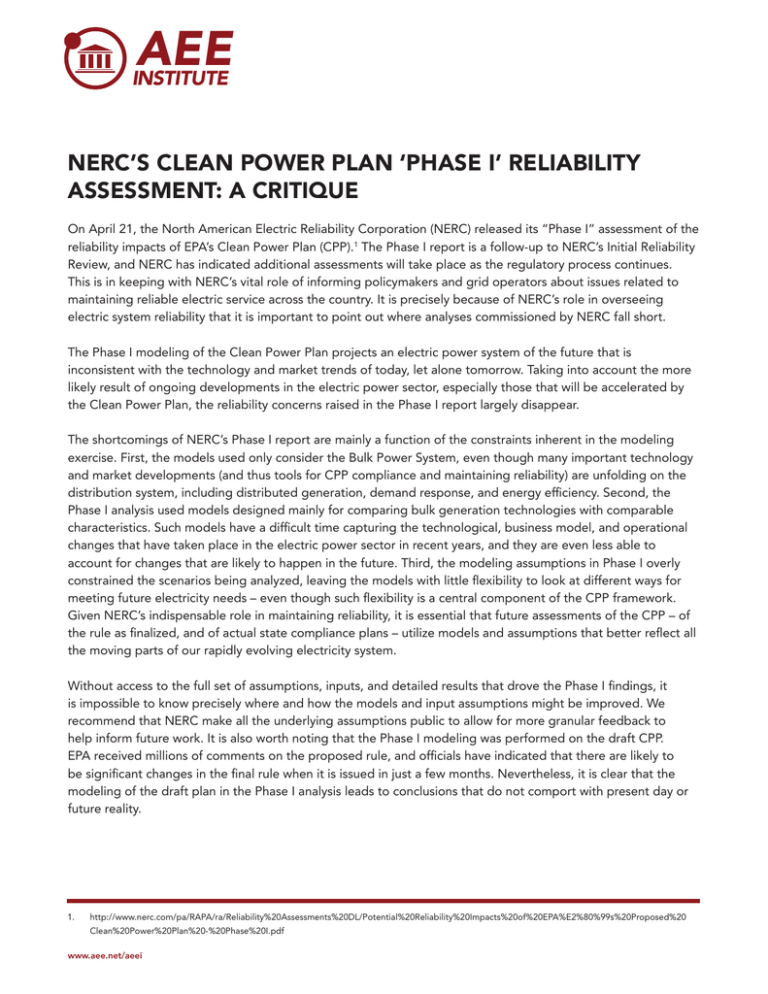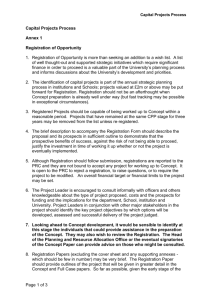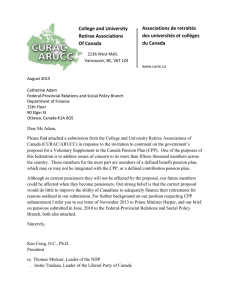AEE NERC’S CLEAN POWER PLAN ‘PHASE I’ RELIABILITY ASSESSMENT: A CRITIQUE INSTITUTE
advertisement

AEE INSTITUTE NERC’S CLEAN POWER PLAN ‘PHASE I’ RELIABILITY ASSESSMENT: A CRITIQUE On April 21, the North American Electric Reliability Corporation (NERC) released its “Phase I” assessment of the reliability impacts of EPA’s Clean Power Plan (CPP).1 The Phase I report is a follow-up to NERC’s Initial Reliability Review, and NERC has indicated additional assessments will take place as the regulatory process continues. This is in keeping with NERC’s vital role of informing policymakers and grid operators about issues related to maintaining reliable electric service across the country. It is precisely because of NERC’s role in overseeing electric system reliability that it is important to point out where analyses commissioned by NERC fall short. The Phase I modeling of the Clean Power Plan projects an electric power system of the future that is inconsistent with the technology and market trends of today, let alone tomorrow. Taking into account the more likely result of ongoing developments in the electric power sector, especially those that will be accelerated by the Clean Power Plan, the reliability concerns raised in the Phase I report largely disappear. The shortcomings of NERC’s Phase I report are mainly a function of the constraints inherent in the modeling exercise. First, the models used only consider the Bulk Power System, even though many important technology and market developments (and thus tools for CPP compliance and maintaining reliability) are unfolding on the distribution system, including distributed generation, demand response, and energy efficiency. Second, the Phase I analysis used models designed mainly for comparing bulk generation technologies with comparable characteristics. Such models have a difficult time capturing the technological, business model, and operational changes that have taken place in the electric power sector in recent years, and they are even less able to account for changes that are likely to happen in the future. Third, the modeling assumptions in Phase I overly constrained the scenarios being analyzed, leaving the models with little flexibility to look at different ways for meeting future electricity needs – even though such flexibility is a central component of the CPP framework. Given NERC’s indispensable role in maintaining reliability, it is essential that future assessments of the CPP – of the rule as finalized, and of actual state compliance plans – utilize models and assumptions that better reflect all the moving parts of our rapidly evolving electricity system. Without access to the full set of assumptions, inputs, and detailed results that drove the Phase I findings, it is impossible to know precisely where and how the models and input assumptions might be improved. We recommend that NERC make all the underlying assumptions public to allow for more granular feedback to help inform future work. It is also worth noting that the Phase I modeling was performed on the draft CPP. EPA received millions of comments on the proposed rule, and officials have indicated that there are likely to be significant changes in the final rule when it is issued in just a few months. Nevertheless, it is clear that the modeling of the draft plan in the Phase I analysis leads to conclusions that do not comport with present day or future reality. 1. http://www.nerc.com/pa/RAPA/ra/Reliability%20Assessments%20DL/Potential%20Reliability%20Impacts%20of%20EPA%E2%80%99s%20Proposed%20 Clean%20Power%20Plan%20-%20Phase%20I.pdf www.aee.net/aeei Specifically, the report predicts that: • Almost all fossil-fuel capacity retirements will be replaced one-for-one with new fossil-fuel bulk generation capacity; • The vast majority of emission reductions will come from increased natural gas generation displacing coal generation; • Growth of renewable energy capacity will slow down, when it might be expected to speed up under the CPP; and • Little additional energy efficiency savings will occur beyond the status quo, even though energy efficiency would reduce both emissions and the need for capacity replacement. What we see in the electric power system even today is very different: renewables are expanding rapidly, efficiency is being deployed by states and private entities at ever higher levels for cost savings, and utilities and grid operators have developed and are continuing to develop various mechanisms to replace capacity and maintain reliability without the need for new large-scale generating units.2,3 The notable disjunction between the trends of today and the Phase I projections for 2020 through 2030 raises questions about the models, the assumptions, and therefore the conclusions of the Phase I assessment regarding reliability. Models Produce Unlikely Results The Phase I report relied on two models to assess resource needs, AURORAxmp and IPM. Two non-CPP scenarios and three CPP compliance scenarios were run through the models: no CPP (business as usual), no CPP assuming low natural gas prices, CPP assuming state-by-state compliance, CPP assuming regional coordination, and CPP assuming low natural gas prices and state-by-state compliance. The AURORAxmp CPP compliance results (but not the IPM results) were then used as inputs into transmission adequacy modeling focused on 2020 summer loading conditions. The results of the resource and transmission modeling were combined with utility survey data on timelines for the necessary projects to develop conclusions about reliability impacts. The report also includes summaries of CPP assessments by regional entities, and recommendations for a reliability assurance mechanism. In this paper, we focus on the resource modeling, as it is the foundation on which all of the analysis and conclusions are based. Both resource models predict high levels of coal retirements and lower generation by remaining coal units, accompanied by large amounts of new natural gas capacity and very little new renewable energy capacity. In essence, these models predict that CPP compliance will come principally from coal-to-gas switching, with natural gas providing roughly 80% of new capacity through 2030 (134-142 GW of the total 169-177 GW), depending on the model and scenario. Under both models, significant coal retirements occur leading up to the compliance period, although it is worth noting that there is insufficient data provided in the Phase I report to determine how many of the retirements are driven by CPP compliance versus other drivers that are present in a business as usual future. NERC should provide a full set of results for the business as usual scenarios along with the compliance scenarios to allow such analysis. 2. http://www.lazard.com/PDF/Levelized%20Cost%20of%20Energy%20-%20Version%208.0.pdf 3. http://info.aee.net/brattle-reliability-report 2 Overall, IPM predicts more retirements than AURORAxmp, especially at the outset, with 31 GW of the total 33-34 GW (94%) of coal retirements occurring by 2020. This frontloading of retirements before the compliance period begins is an unlikely outcome given that the CPP allows states the flexibility to set their own emission reduction trajectory as long as they achieve specified average emission reductions over the 10-year compliance period (2020-2030). For both economics and reliability, it would make more sense for utilities to spread emission reductions out rather than trying to achieve nearly all of these reductions by 2020. Indeed, modeling by PJM Interconnection indicates that retirements would occur gradually throughout the compliance period. After analyzing many different compliance scenarios, PJM also concluded that adding more energy efficiency and renewable energy would result in lower CO2 prices, in turn alleviating the financial pressures on fossil resources and reducing the amount of fossil capacity at risk of retirement.4 The AURORAxmp model also produced one particularly curious result with regard to coal: For the scenario assuming low natural gas prices, AURORAxmp shows coal generation increasing between 2015 and 2019 before dropping off sharply at the beginning of the CPP compliance period. Given current and continuing trends, environmental regulations that have already gone into effect, and the low gas prices assumed in this scenario, projecting an increase in coal generation begs further explanation. However, the most striking element of the Phase I modeling is the projected new renewable capacity, which falls far short of what is occurring today even without the impetus of the CPP to develop zero-emission power sources. The models show an average of just 2-4 GW per year of growth in non-hydro renewable energy capacity from 2016 to 2030 under any of the CPP compliance scenarios. Even at the high end, this projection is less than half of the 9.7 GW annual growth of non-hydro renewable energy capacity that has been installed, on average, from 2008 to 2014.5 The Phase I projections for solar energy range from 12 to 20 GW of new capacity installed through 2030 (about 0.8-1.6 GW annually), whereas current industry projections estimate that nearly 20 GW of solar capacity will be added in just two years, from 2015 to 2016. In 2014 alone, the solar industry installed more than 6 GW of new solar generating capacity.6 The IPM model is even more pessimistic about wind installations, predicting that just 2 GW of new capacity will be added over the 10-year period from 2020 to 2030, or an average of 200 MW of wind power annually. That would be the equivalent of adding just one large wind farm in the country per year – a stark departure from historical trends. Over the past six years, annual wind capacity installations have averaged approximately 6,700 MW, or more than 30 times the IPM model’s annual projection for 2020-2030.7 The Phase I report notes that the low levels of renewable energy growth are driven in part by the assumption that federal tax credits for wind and solar will not be renewed. Even if that were to be the case, rapid cost declines should allow renewable energy to continue to grow more than these models predict, especially in a carbon constrained system that favors zero-emitting sources and makes generation from emitting sources more expensive. For example, wind prices have dropped to as low as 4.5 cents/kWh in some areas, even without the federal Production Tax Credit (PTC).8 Similarly, according to a 2015 report published by Deutsche Bank, rooftop solar will reach or exceed grid parity in 41 states by 2017, even with a step-down of the investment tax credit (ITC).9 4. https://www.pjm.com/~/media/documents/reports/20150302-pjm-interconnection-economic-analysis-of-the-epa-clean-power-plan-proposal.ashx 5. http://www.ferc.gov/legal/staff-reports/2014/dec-infrastructure.pdf; and http://www.nrel.gov/docs/fy15osti/62580.pdf 6. http://www.seia.org/research-resources/us-solar-market-insight. Note that this figure is reported based on the DC rating of the solar. We estimate that this represents approximately 5 GW of solar based on net AC output. 7. http://www.ferc.gov/legal/staff-reports/2014/dec-infrastructure.pdf and http://emp.lbl.gov/sites/all/files/2013_Wind_Technologies_Market_Report_Final3.pdf 8. http://www.energy.gov/sites/prod/files/WindVision_Report_final.pdf 9. https://www.db.com/cr/en/docs/solar_report_full_length.pdf 3 It is also noteworthy that there is almost no difference in renewable energy additions between the modeled reference scenario and the CPP compliance scenarios using either model. Over the entire compliance period there is an average annual difference of just 0.6 GW between IPM’s CPP and non-CPP scenarios. Such a result implies that in a carbon constrained power sector, there would be almost no incentive to build new renewables – a curious result, especially given the downward trends in renewable energy costs and the impact the CPP would have on the relative price of emitting resources.10,11 Assumptions Lead to Questionable Conclusions In any modeling exercise, results are driven by the modeling inputs and other assumptions, such as scenario definitions. Without access to most of the underlying data and detailed results, we cannot conduct a comprehensive assessment of the Phase I report. Nevertheless, based on the information made public to date, it appears that the model assumptions poorly reflect the trends currently shaping our electricity system and the ways the CPP will impact that system. In particular, there at least five major assumptions incorporated into the Phase I modeling that are driving the unlikely results discussed above. These assumptions should be rethought for future assessments. Assumption #1: Existing Bulk Generation Will Be Replaced by New Bulk Generation The Phase I modeling framework uses a standard least cost optimization approach, built around one fundamental assumption: “new utility-scale generation will be constructed to replace existing generation and meet electricity demand in the future.” As the report states, “From NERC’s perspective, the path to achieve the significant reductions in CO2 emissions is through resource mix changes on the BPS [bulk power system].” In addition to assuming essentially a one-for-one replacement of retiring utility-scale generation with new utility-scale generation, the Phase I study assumes that demand growth is fixed at 1% (a NERC presentation summarizing the report indicates the figure is actually 1.1%) annually through 2030. In fact, the modeling appears to have used a fixed assumption about energy efficiency potential and put that into a static demand curve that is the same in all scenarios. By assuming fixed electricity demand across the scenarios, the analysis ignores the potential to: • Reduce overall demand by allowing energy efficiency to compete on cost, • Actively manage demand via demand response – a well developed tool that has already proven itself important in supporting grid reliability, and • Deploy substantial distributed resources, including the burgeoning solar market and rapidly evolving options for energy storage. The report itself acknowledges that the models do not consider these potential resources, saying, “significant additional conservation and distributed generation would have an impact on the results.” Given that growing energy efficiency and distributed generation deployment are two important trends shaping the electric power sector today, this statement is an acknowledgment that the modeling results do not accurately reflect market reality. 10. http://www.energy.gov/sites/prod/files/WindVision_Report_final.pdf 11. http://www.seia.org/research-resources/solar-market-insight-report-2013-year-review 12. http://documents.dps.ny.gov/public/MatterManagement/CaseMaster.aspx?MatterSeq=45800&MNO=14-E-0302 4 Energy efficiency, distributed generation, and other advanced energy options are rapidly becoming hallmarks of an intelligent, customer-focused 21st century grid that utilizes these resources in part to reduce major capital expenditures. For example, in New York, Consolidated Edison expects to defer a $1 billion transmission and distribution upgrade by investing $200 million in distributed energy resources, including energy storage, demand response and distributed generation.12 Such investments have already proven indispensible to maintaining reliable electricity throughout the country. During the 2014 polar vortex, PJM Interconnection hit a wintertime load record of 138,600 MW, and ERCOT’s demand rose to within 2,000 MW of total available capacity. In response, grid operators called on demand response for savings of 1,900 MW (PJM) and 1,600 MW (ERCOT) to help prevent blackouts.13 Residential solar installations are leading the rise of distributed generation having experienced year-overyear growth rates above 50% each year since 2012, such that the residential solar industry installed over 1.2 GW of systems in 2014 alone.14 Likewise, the building efficiency market has grown 43% since 2011, and a new Lawrence Berkeley National Laboratory study of utility efficiency programs in 20 states from 2009-2013 concluded that the total cost of saved electricity in those programs averaged a highly competitive 4.6 cents/ kWh, or about half the price of retail electricity.15,16 Clearly, reliance on these resources is not reserved for some speculative future scenario, but is an existing and accelerating reality. Beyond overlooking efficiency and distributed generation, the Phase I BPS assumption also ignores many of the operational tools that utilities are developing and deploying to reduce major capital expenditure projects such as new bulk generation capacity. These technologies and operational tools are being used to manage a grid that is already undergoing a transformation that, as NERC recognizes, the Clean Power Plan will only accelerate. For instance, ISO New England’s new “Pay-for-Performance” rules will create a market incentive for more reliable natural gas supply during times of peak winter demand. Grid operators have a number of options for increasing the flexibility of the BPS by gathering, analyzing, and incorporating real-time data into system operations. For example, grid operators can reduce congestion on the transmission system through dynamic line ratings, adaptive line ratings, and transmission topology control.17 At the distribution level, advanced metering, distribution automation, and advanced distribution management systems are improving the flexibility and performance of the distribution system, ensuring continued reliability without the need for new generating capacity. While it can be challenging to translate improved grid management into data inputs for a model, they are important determinants of the future structure of the power grid and its ability to maintain reliability with changing resources. In the end, the assumption that new bulk power generation will be required to replace existing bulk power generation leaves out a range of solutions, at both the wholesale and retail levels, that would address some of the changes resulting from unit retirements without replacing them, MW for MW. In doing so, the assumption inflates the need for investment in new traditional utility-scale generation, especially natural gas units. Assumption #2: States Have to Meet Annual Emission Caps Under the proposed CPP, states are allowed to use either EPA’s rate-based targets (i.e., pounds of CO2 emitted per MWh of electricity generated) or EPA’s mass-based targets (i.e., total pounds of CO2). The Phase I report 13. http://blog.opower.com/2014/01/an-olympic-sized-challenge-across-us-demand-response-is-helping-utilities-navigate-treacherous-winter-peaks/ 14. http://www.seia.org/sites/default/files/HOlFT6ym3i.pdf 15. http://info.aee.net/aen-2015-market-report 16. http://emp.lbl.gov/publications/total-cost-saving-electri 17. http://info.aee.net/brattle-reliability-report 5 uses the mass-based targets, which is a reasonable choice for modeling purposes. Unfortunately, there is a fundamental flaw in the implementation of these targets in the Phase I models. Under EPA’s proposal, states are allowed to plan their own emission trajectory as long as the average emission level for the compliance period meets the goals set by EPA. The Phase I report replaces that flexibility with fixed annual emission caps for each state, which has significant implications for the results. The approach creates a “cliff” in 2020, when coal-fired generation falls substantially because the models force 80% of the total reductions to happen by the first year of compliance. In reality, states have 10 years over which to manage the reductions. This approach not only minimizes the contributions of resources such as energy efficiency, which contributes compounding reductions each year, but it also raises undue reliability concerns by assuming that the electricity system must undergo a large near-term transition.18 The report explains that this assumption reflects the fact that industry always “over complies” with regulation. However, it does not follow that over-compliance must take the form of achieving most of the reductions for the 10-year compliance period by the first year. In fact, over-compliance could be modeled just as easily – and more accurately – by setting more aggressive overall emission targets for the states while still allowing those reductions to be spread more naturally across the compliance period. Instead, by creating an artificial cliff, the report concludes that the CPP would force change in the system more quickly than it could handle. Somewhat ironically, given Assumption #1, if we were to assume for a moment that such steep reductions were actually needed in 2020, some of the best tools for managing such a transition would be demand response and energy efficiency, which can be deployed relatively quickly and with low capital costs.19 These measures would relieve pressure to build substantial new generating capacity before 2020 and ease any transmission-related constraints resulting from the changing capacity mix. Assumption #3: Credit Trading Must Follow Power Flow The Phase I Report assumes that all emission reduction credits must follow the flow of power, meaning that the emission reduction benefits from a natural gas combined cycle plant or wind power facility, for example, must be counted (“retired”) in the state or region where the electricity from that power plant is used. This “bundling” of emission credits with their associated electrons prevents generators from purchasing emission reduction credits from any entity to which they are not physically connected on the power grid and able to take delivery of the power. The result is an inefficient marketplace. Generators trying to minimize cost cannot buy the cheapest emission reduction credits available; instead they are restricted to the credits available within their transmission area. This constraint artificially drives up cost and incentivizes compliance action beyond economically optimal levels. That’s because a credit shortage in a particular transmission area would spur new action (such as new natural gas plant construction) in that area even if credits were available elsewhere. Such restricted trading also takes away flexibility from plant operators when balancing CPP compliance and reliability objectives during unforeseen reliability events. The restricted flexibility and resulting shifts in power flows feed many of the Phase I conclusions regarding reliability concerns, yet the bundling that drives these challenges is a limitation imposed by the model assumptions, not by the CPP. In fact, the Clean Air Act (CAA) specifically allows EPA to adopt “economic incentives, such as marketable permits or auctions of emission allowances” for compliance purposes. Full, 18. http://info.aee.net/brattle-reliability-report 19. http://www.ieca-us.com/wp-content/uploads/Carbon-Dioxide-Reductions-from-Demand-Response_Navigant_11.25.14.pdf 6 unbundled trading of emission allowances already occurs under other CAA rules, including the Acid Rain Program, Clean Air Interstate Rule, and Cross-State Air Pollution Rule, meaning that such credit trading is both legally defensible and logistically possible, with the latter point further corroborated by robust markets for unbundled renewable energy credits (RECs) in states with existing renewable portfolio standards (RPS).20 Given the distinct possibility that state or regional plans will take advantage of unbundled emission trading, other models and assessments of CPP outcomes have incorporated this option. Modeling by the Bipartisan Policy Center (BPC), for example, assumes “trading among all sources,” while Morgan Stanley allows for full trading in its modeling of CPP compliance, and the Center for Strategic & International Studies and the Rhodium Group assume a tradable performance compliance approach where units trade unbundled emission credits.21 Similarly, the Nicholas Institute at Duke University proposed a flexible CPP compliance approach based on the assumption that states will trade credits freely even in the absence of regional coordination whenever their individual plans allow.22 As states contemplate unbundled credit trading for part or all of their compliance plans, it is important that NERC provide an assessment of reliability under such a system, both state-by-state and regionally. Assumption #4: States Will Have Few Tools for Compliance As noted above, the models’ guiding parameter of one-for-one bulk generating capacity replacement artificially restricts the technology options available for compliance, as it rules out such alternatives as demand response and distributed generation in assessing the CPP’s impact. The models put further limits on the contribution of technologies and services expressly included in the Building Blocks of emission reduction that EPA used to set CPP targets. First, the report assumes that existing coal plants can only achieve a 1.1% heat rate improvement (i.e., the efficiency with which they use coal to generate electricity) while EPA assumed potential heat rate improvement of 6%. The difference is stark, given that EPA’s 6% assumption did not consider a number of unit-level options for reducing emissions rates, including fuel mixture alterations, waste heat recovery, co-firing with biomass or fuel oil, and some combined heat and power (“CHP”) conversions. While these are not heat rate improvement per se, they all have the effect of reducing the emissions of the existing coal fleet.23 Second, the low projected growth rates of renewable generation discussed above mean that these resources do not contribute significantly to CPP compliance in the Phase I models. The projections raise questions about the cost and performance assumptions about these resources. The report explains that the expiration of the federal production tax credit (PTC) and the scheduled reduction of the investment tax credit (ITC) from 30% to 10% for utility-scale solar will make renewable energy uncompetitive with natural gas. However, the CO2 shadow pricing included in the models should either partially or completely offset that differential, making this explanation incomplete. More importantly, wind and solar technologies continue to improve and are becoming increasingly cost competitive. Solar PV system costs have consistently declined 6-8% each year from 1998 to 2013, and in 2014 the average system cost declined 10%, such that fixed tilt utility-scale PV cost $1.55 per watt.24,25 20. http://www.epa.gov/airmarkets/participants/allowance/index.html 21. http://bipartisanpolicy.org/wp-content/uploads/2015/04/BPC-Clean-Power-Plan-Slides.pdf; http://mgstn.ly/1OMEmLr; http://rhg.com/wp-content/uploads/2014/11/RemakingAmericanPower.pdf 22. http://nicholasinstitute.duke.edu/sites/default/files/publications/ni_pb_15-01.pdf 23. http://info.aee.net/brattle-reliability-report 24. http://www.nrel.gov/docs/fy14osti/62558.pdf?utm_source=Solar%20Energy %20Prices%20See. 25. http://www.seia.org/sites/default/files/HOlFT6ym3i.pdf 7 According to a 2015 report published by Deutsche Bank, rooftop solar will be as cheap or cheaper than average electricity prices in 41 states by 2017, even when factoring in a step-down of the ITC.26 Meanwhile, customers and utilities are increasingly selecting wind power on the basis of economics. In 2013, Xcel Energy signed PPAs for 700 MW of wind energy, at prices below most of its natural gas-fired generation.27 These contracts are expected to save the utility as much as $590 million in fuel costs over the next 20 years for its Texas and New Mexico customers, while Xcel says it has saved $37.5 million from avoided coal and gas purchases from 2009 to 2014 thanks to its current wind assets.28 A recent Department of Energy report found that wind has dropped to as low as 4.5 cents/kWh in some areas, even without the PTC.29 Though the details of wind and solar pricing in the Phase I models are not currently available, the apparent assumption that these technologies will not become more competitive over the next 15 years, especially considering their value in emission reduction under the CPP, seems unrealistic. Third, total electricity demand (and therefore the implied potential for energy efficiency in reducing emissions) appears to be a fixed input to the model across the scenarios, as discussed with regard to Assumption #1, above. The inelasticity of demand in response to price changes from CPP compliance means that the models do not show any potential for states to increase energy efficiency levels as a mechanism of compliance. In fact, it appears that the actual level of energy efficiency built into the compliance scenarios is quite low. Although it is not possible to verify without the full input assumptions, it appears that the Phase I assessment assumes that states can achieve up to roughly 0.55% per year in energy savings on average, based on data from the Electric Power Research Institute,30 whereas EPA’s analysis indicates that states can reach 1.5% savings per year. The Phase 1 savings figure appears particularly conservative given that a number of states have utility-based energy efficiency programs that already, as of 2013, achieved levels of savings higher than EPA’s estimate: Rhode Island (2.09%), Massachusetts (2.05%), Vermont (1.78%), Arizona (1.74%), Hawaii (1.67%), and Michigan (1.51%).31 The unduly conservative expectations for energy efficiency are also evident in the Phase I demand growth projections. The Phase I report assumed 1% (or 1.1%, as stated in the NERC media briefing) annual demand growth, which is significantly higher than EIA’s Annual Energy Outlook 2015 (AEO 2015) reference case prediction of 0.8% annual demand growth. The discrepancy is particularly notable because both demand growth assumptions incorporate energy efficiency at some level. However, the AEO 2015 only incorporates energy efficiency from existing policies, while the Phase I demand growth under the CPP scenarios should include both energy efficiency from existing policies and additional energy efficiency resulting from CPP compliance. And yet, the demand growth appears to be higher under the Phase I CPP compliance scenarios. If true, the Phase I report may actually incorporate less energy efficiency under the CPP than EIA predicts would occur under business as usual. Energy efficiency is already big business for utilities and the private sector alike, and one should expect this to be a key tool in meeting the CPP – and be taken into account in any modeling of CPP’s impact. Beyond the Building Blocks, the Phase I analysis also restricts the contributions of technologies and services not incorporated into the blocks, but which EPA explicitly allows states to pursue for emission reduction opportunities. For example, as discussed above, demand response is a widespread, low-cost, fast-to-implement solution for managing peak demand, enhancing reliability, and reducing emissions, for which FERC finds there 26. https://www.db.com/cr/en/docs/solar_report_full_length.pdf 27. http://aweablog.org/blog/post/citing-low-costs-xcel-energy-plans-significant-increase-in-wind-purchases 28. http://www.bizjournals.com/denver/blog/earth_to_power/2014/04/wind-powers-xcel-energy-to-top-of-the-charts-again.html?page=all 29. http://www.energy.gov/sites/prod/files/WindVision_Report_final.pdf 30. http://www.epri.com/abstracts/Pages/ProductAbstract.aspx?ProductId=000000000001025477 31. http://aceee.org/research-report/u1408 8 is substantial untapped potential in the United States.32,33 Other omissions include combined heat and power (CHP), private sector energy efficiency delivered outside utility programs, enhanced building codes, and transmission and distribution efficiency improvements (e.g., Volt-VAR optimization). The end result from the models given these restrictions is quite predictable: with limited alternatives, the models are forced to project an increase of natural gas generation to replace coal as the primary means of compliance. While this result may flow naturally from the model inputs and assumptions, it does not flow naturally from the reality of the electric power system today. Assumption #5: Few Compliance Scenarios Are Worth Studying Another missing link in the Phase I analysis is a robust consideration of a broad variety of inputs and assumptions. The two models were run under scenarios differing according to only two variables: (i) state vs. regional compliance and (ii) reference vs. low gas price. This means that all other assumptions feeding the models stand as fact, unchecked and untested. For example, the report does not examine a scenario in which renewable energy technology costs decline more rapidly, which seems conspicuously absent given the market trend for solar and wind costs. Similarly, as stated above, the Phase I study uses a steady 1% demand growth across every model run, rather than testing the impact of higher energy efficiency levels bending demand downward. The models do consider low gas prices, but do not allow for high gas prices, which would seem a prudent addition given the volatility of gas prices in the past, and the fact that the models are unlikely to behave in a linear fashion with respect to fuel prices.34 These examples only scratch the surface. With so many uncertainties—how EPA will design the final rule, how states will approach compliance, and how quickly technologies will advance—it only makes sense to diversify the assumptions feeding the models and test a range of scenarios. When combined with a lack of access to the Phase I input data and detailed results, the limited scenario runs also obscure the potential sensitivity of the models to particular inputs. Factoring in additional variables would identify important patterns: areas of agreement and areas of divergence. This would provide more robust results that would improve our understanding of likely compliance outcomes, as well as exposing the impact of individual assumptions. Including additional scenarios beyond the four considered in the Phase I study is not unrealistic; rather, this would bring the report in line with other industry reports. In its modeling of the Clean Power Plan, PJM Interconnection (PJM) considered no fewer than 17 different scenarios, looking at a reference “no-CPP” case for each scenario for a total of 34 different modeled outcomes. According to PJM’s report, “The scenarios covered varying combinations and levels of renewable resources, energy efficiency, natural gas prices, nuclear generation and new entry of natural gas combined-cycle resources.”35 The Mid-continent Independent System Operator (MISO) modeled seven different variables with a total of 20 different sub-variables, accounting for all possible combinations therein for a total of 1,296 different scenarios.36 Similarly, the Bipartisan Policy Center’s (BPC’s) initial modeling looked at 15 total scenarios, including model runs with high, low, and medium levels of energy efficiency.37 32. http://www.ieca-us.com/wp-content/uploads/Carbon-Dioxide-Reductions-from-Demand-Response_Navigant_11.25.14.pdf 33. http://www.ferc.gov/legal/staff-reports/06-09-demand-response.pdf 34. http://www.eia.gov/pub/oil_gas/natural_gas/feature_articles/2007/ngprivolatility/ngprivolatility.pdf 35. https://www.pjm.com/~/media/documents/reports/20150302-pjm-interconnection-economic-analysis-of-the-epa-clean-power-plan-proposal.ashx 36. https://www.misoenergy.org/Library/Repository/Communication Material/EPA Regulations/AnalysisofEPAProposalReduceCO2Emissions.pdf 37. http://bipartisanpolicy.org/wp-content/uploads/2015/04/BPC-Clean-Power-Plan-Slides.pdf 9 Given the challenges of modeling future outcomes in the highly dynamic and complex electricity system, it only makes sense to cover a broad range of possibilities in order to drive more robust results and conclusions. Conclusion NERC has stated that the CPP will accelerate changes already occurring in the electric power system, and we agree. These changes - replacing aging infrastructure and modernizing an outdated system with new technologies and new consumer options - are needed, and we believe the industry is more than up to the task. However, the future is going to be much more dynamic and the resources more diversified than the Phase I analysis suggests. When one considers that, under the Phase I analysis, emission reduction options are constrained to new utility scale generation replacing existing generation, renewables growth slows down rather than speeds up despite constraints on carbon, states are forced to meet annual targets with most emission reductions required by year one, and emission reduction crediting is artificially constrained, it is hardly surprising that the Phase I modeling shows only one real option for CPP compliance: building a great deal of natural gas capacity in a short period of time. Such a conclusion is reinforced when the only alternative scenario (beyond a look at regional compliance) is an examination of a future with low gas prices. While increased use of natural gas will be a component of CPP compliance, this singular outcome is a product of the model capabilities and input assumptions, not the realities of the market today or where the industry is headed, with or without the CPP.38 Given the relative implausibility of the predicted outcomes, the conclusions drawn from them regarding reliability are equally unlikely to hold true. In particular, concerns over the volume and timing of retirements, new capacity additions, and associated transmission and pipeline capacity build-out are largely driven by the heavy reliance on a single resource for compliance and an artificially forced timeline for reductions. With more savings from energy efficiency and demand management, more growth in renewable energy generation (utility scale and distributed), and wider use of grid management tools available today (and even more tomorrow), the need for excessive build-out of natural gas generation falls away. Nor is there reason to think that this more diversified approach would create a different set of reliability concerns. For instance, the fact that a number of regions are already successfully integrating higher levels of renewable energy capacity than is contemplated in this modeling or EPA’s own modeling indicates that renewables integration is an unlikely reliability concern for the CPP. NERC shoulders the important responsibility of safeguarding the reliability of the electric power system that we count on for comfort, convenience, and commerce. In assessing the EPA’s Clean Power Plan, NERC also faces a daunting challenge: predicting the future of a rapidly changing electric power sector. As the issuance of the final rule approaches, to be followed by development of state compliance plans, NERC needs a much more dynamic and forward-looking methodology for assessing impacts than was used in its Phase I report. We hope this critique, offered in a spirit of collaboration, will help NERC move toward that goal. 38. http://info.aee.net/brattle-reliability-report 10





